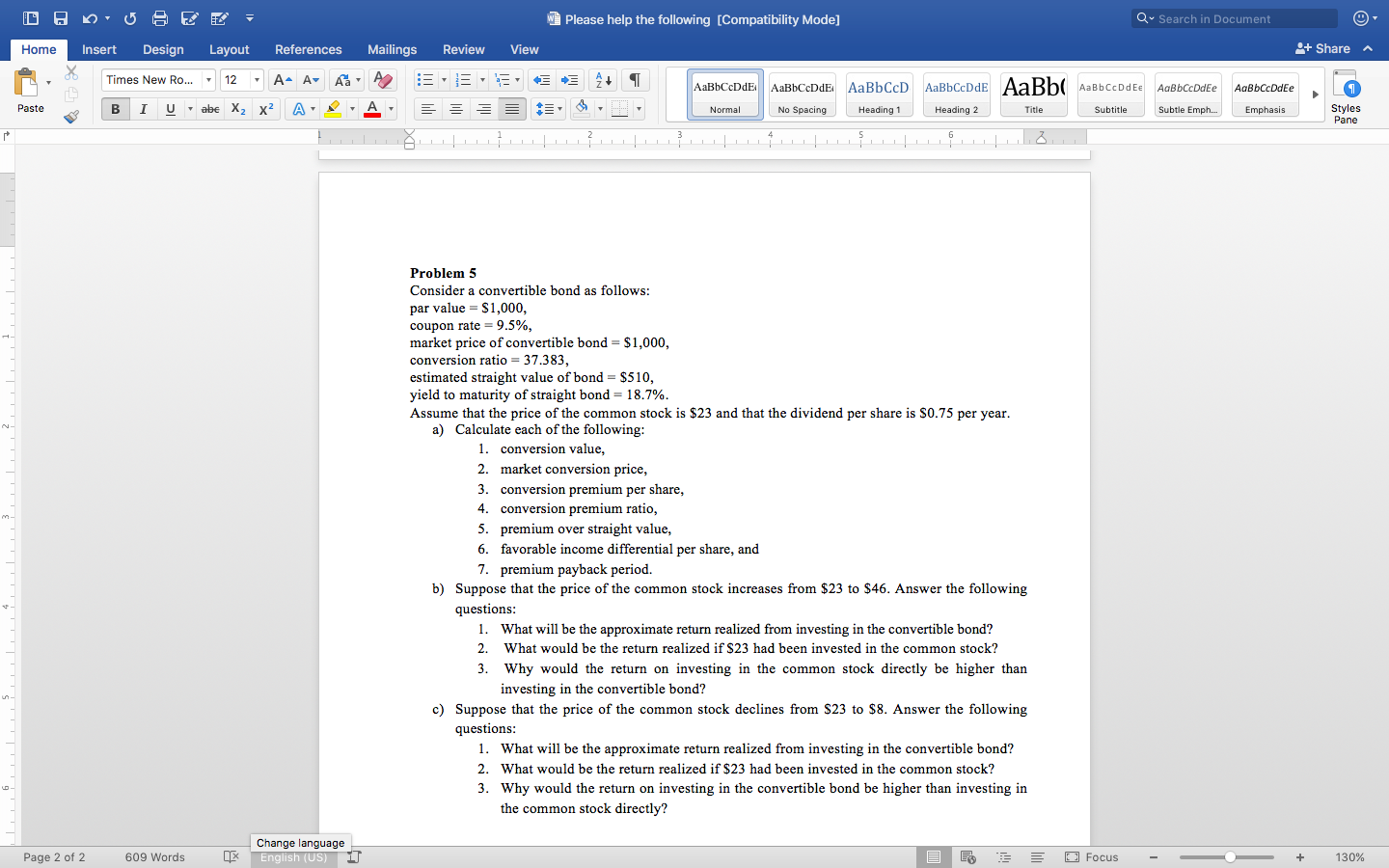
W Please help the following [Compatibility Mode] Qw Search in Document + Share Home Insert Design Layout References Mailings Review 8 Times New Ro... 12 - Aa A Aa A :5, E B I vabe X, X AA = 3 View 5 + AaBbCcDdE AaBbCcDdE: AaBbCcD AaBbCcDdE AaBb Normal No Spacing Heading 1 Heading 2 Title AaBbCcDdEe AaBbCcDdee Subtle Emph... AaBbCcDdee Emphasis Paste 0 Styles Pane Problem 5 Consider a convertible bond as follows: par value = $1,000, coupon rate = 9.5%, market price of convertible bond = $1,000, conversion ratio = 37.383, estimated straight value of bond = $510, yield to maturity of straight bond = 18.7%. Assume that the price of the common stock is $23 and that the dividend per share is $0.75 per year. a) Calculate each of the following: 1. conversion value, 2. market conversion price, 3. conversion premium per share, 4. conversion premium ratio, 5. premium over straight value, 6. favorable income differential per share, and 7. premium payback period. b) Suppose that the price of the common stock increases from $23 to $46. Answer the following questions: 1. What will be the approximate return realized from investing in the convertible bond? 2. What would be the return realized if $23 had been invested in the common stock? 3. Why would the return on investing in the common stock directly be higher than investing in the convertible bond? c) Suppose that the price of the common stock declines from $23 to $8. Answer the following questions: 1. What will be the approximate return realized from investing in the convertible bond? 2. What would be the return realized if $23 had been invested in the common stock? 3. Why would the return on investing in the convertible bond be higher than investing in the common stock directly? Page 2 of 2 609 Words Change language English (US) IT E D Focus - - - + 130% W Please help the following [Compatibility Mode] Qw Search in Document + Share Home Insert Design Layout References Mailings Review 8 Times New Ro... 12 - Aa A Aa A :5, E B I vabe X, X AA = 3 View 5 + AaBbCcDdE AaBbCcDdE: AaBbCcD AaBbCcDdE AaBb Normal No Spacing Heading 1 Heading 2 Title AaBbCcDdEe AaBbCcDdee Subtle Emph... AaBbCcDdee Emphasis Paste 0 Styles Pane Problem 5 Consider a convertible bond as follows: par value = $1,000, coupon rate = 9.5%, market price of convertible bond = $1,000, conversion ratio = 37.383, estimated straight value of bond = $510, yield to maturity of straight bond = 18.7%. Assume that the price of the common stock is $23 and that the dividend per share is $0.75 per year. a) Calculate each of the following: 1. conversion value, 2. market conversion price, 3. conversion premium per share, 4. conversion premium ratio, 5. premium over straight value, 6. favorable income differential per share, and 7. premium payback period. b) Suppose that the price of the common stock increases from $23 to $46. Answer the following questions: 1. What will be the approximate return realized from investing in the convertible bond? 2. What would be the return realized if $23 had been invested in the common stock? 3. Why would the return on investing in the common stock directly be higher than investing in the convertible bond? c) Suppose that the price of the common stock declines from $23 to $8. Answer the following questions: 1. What will be the approximate return realized from investing in the convertible bond? 2. What would be the return realized if $23 had been invested in the common stock? 3. Why would the return on investing in the convertible bond be higher than investing in the common stock directly? Page 2 of 2 609 Words Change language English (US) IT E D Focus - - - + 130%







